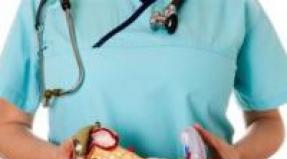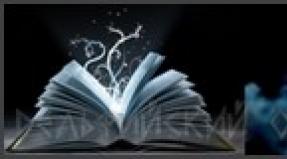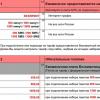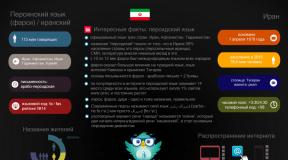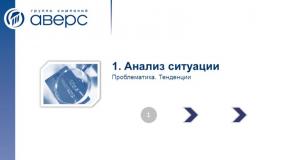G40-G47 Episodic and paroxysmal disorders. Paroxysmal atrial fibrillation: clinic, diagnosis, treatment, emergency care G25 Other extrapyramidal and movement disorders
Class VI. Diseases nervous system(G00-G47)
This class contains the following blocks:
G00-G09 Inflammatory diseases of the central nervous system
G10-G13 Systemic atrophies predominantly affecting the central nervous system
G20-G26 Extrapyramidal and other movement disorders
G30-G32 Other degenerative diseases of the central nervous system
G35-G37 Demyelinating diseases of the central nervous system
G40-G47 episodic and paroxysmal disorders
INFLAMMATORY DISEASES OF THE CENTRAL NERVOUS SYSTEM (G00-G09)
G00 Bacterial meningitis, not elsewhere classified
Includes: arachnoiditis)
leptomeningitis)
meningitis) bacterial
pachymeningitis)
Excludes: bacterial:
meningoencephalitis ( G04.2)
meningomyelitis ( G04.2)
G00.0 Influenza meningitis. Meningitis due to Haemophilus influenzae
G00.1 Pneumococcal meningitis
G00.2 Streptococcal meningitis
G00.3 Staphylococcal meningitis
G00.8 Meningitis caused by other bacteria
Meningitis caused by:
Friedlander's wand
Escherichia coli
Klebsiella
G00.9 Bacterial meningitis unspecified
Meningitis:
purulent NOS
pyogenic NOS
pyogenic NOS
G01* Meningitis in bacterial diseases classified elsewhere
Meningitis (for):
anthrax ( A22.8+)
gonococcal ( A54.8+)
leptospirosis ( A27. -+)
listeriosis ( A32.1+)
Lyme disease ( A69.2+)
meningococcal ( A39.0+)
neurosyphilis ( A52.1+)
salmonellosis ( A02.2+)
syphilis:
congenital ( A50.4+)
secondary ( A51.4+)
tuberculosis ( A17.0+)
typhoid fever ( A01.0+)
Excludes: meningoencephalitis and meningomyelitis due to bacterial
diseases classified elsewhere ( G05.0*)
G02.0* Meningitis with viral diseases, classified elsewhere
Meningitis (caused by a virus):
adenovirus ( A87.1+)
enteroviral ( A87.0+)
herpes simplex ( B00.3+)
infectious mononucleosis ( B27. -+)
measles ( B05.1+)
mumps (mumps) B26.1+)
rubella ( B06.0+)
chicken pox ( B01.0+)
shingles ( Q02.1+)
G02.1* Meningitis with mycoses
Meningitis (for):
candidiasis ( B37.5+)
coccidioidomycosis ( B38.4+)
cryptococcal ( B45.1+)
G02.8* Meningitis in other specified infectious and parasitic diseases classified elsewhere
Meningitis due to:
African trypanosomiasis ( B56. -+)
Chagas disease ( B57.4+)
G03 Meningitis due to other and unspecified causes
Includes: arachnoiditis)
leptomeningitis) due to other and unspecified
meningitis) causes
pachymeningitis)
Excludes: meningoencephalitis ( G04. -)
meningomyelitis ( G04. -)
G03.0 Non-pyogenic meningitis. Non-bacterial meningitis
G03.1 chronic meningitis
G03.2 Benign recurrent meningitis [Mollare]
G03.8 Meningitis due to other specified pathogens
G03.9 Meningitis, unspecified. Arachnoiditis (spinal) NOS
G04 Encephalitis, myelitis and encephalomyelitis
Includes: acute ascending myelitis
meningoencephalitis
meningomyelitis
Excludes: benign myalgic encephalitis ( G93.3)
encephalopathy:
NOS ( G93.4)
alcoholic genesis ( G31.2)
toxic ( G92)
multiple sclerosis (G35)
myelitis:
acute transverse ( G37.3)
subacute necrotizing ( G37.4)
G04.0 Acute disseminated encephalitis
encephalitis)
Encephalomyelitis) post-immunization
If necessary, identify the vaccine
G04.1 Tropical spastic paraplegia
G04.2 Bacterial meningoencephalitis and meningomyelitis, not elsewhere classified
G04.8 Other encephalitis, myelitis and encephalomyelitis. Postinfectious encephalitis and encephalomyelitis NOS
G04.9 Encephalitis, myelitis or encephalomyelitis, unspecified. Ventriculitis (cerebral) NOS
G05* Encephalitis, myelitis and encephalomyelitis in diseases classified elsewhere
Includes: meningoencephalitis and meningomyelitis in diseases
classified elsewhere
If necessary, identify infectious agent use additional code ( B95-B97).
G06.0 Intracranial abscess and granuloma
Abscess (embolic):
brain [any part]
cerebellar
cerebral
otogenic
Intracranial abscess or granuloma:
epidural
extradural
subdural
G06.1 Intravertebral abscess and granuloma. Abscess (embolic) spinal cord[any part]
Intravertebral abscess or granuloma:
epidural
extradural
subdural
G06.2 Extradural and subdural abscess, unspecified
G07* Intracranial and intravertebral abscess and granuloma in diseases classified elsewhere
brain abscess:
amoebic ( A06.6+)
gonococcal ( A54.8+)
tuberculosis ( A17.8+)
Cerebral granuloma in schistosomiasis B65. -+)
Tuberculoma:
brain ( A17.8+)
meninges (A17.1+)
G08 Intracranial and intravertebral phlebitis and thrombophlebitis
Septic(s):
embolism)
endophlibitis)
phlebitis) intracranial or intravertebral
thrombophlebitis) venous sinuses and veins
thrombosis)
Excludes: intracranial phlebitis and thrombophlebitis:
complicating:
abortion, ectopic or molar pregnancy ( O00
-O07
, O08.7
)
pregnancy, childbirth or postpartum period (O22.5, O87.3)
non-purulent origin ( I67.6); non-purulent intravertebral phlebitis and thrombophlebitis ( G95.1)
G09 Sequelae of inflammatory diseases of the central nervous system
Note This rubric should be used to refer to
conditions primarily classified under headings
G00-G08(excluding those marked with *) as the cause of consequences that are themselves attributed to
Other headings The term "sequelae" includes conditions specified as such or as late manifestations or effects existing for a year or more after the onset of the causing condition. When using this rubric, one should be guided by the relevant recommendations and rules for coding morbidity and mortality given in v.2.
SYSTEMIC ATROPHY AFFECTING PREFERENTIALLY THE CENTRAL NERVOUS SYSTEM (G10-G13)
G10 Huntington's disease
Huntington's chorea
G11 Hereditary ataxia
Excludes: hereditary and idiopathic neuropathy ( G60. -)
children's cerebral paralysis (G80. -)
metabolic disorders ( E70-E90)
G11.0 Congenital non-progressive ataxia
G11.1 Early cerebellar ataxia
Note Usually starts in people under 20 years of age
Early cerebellar ataxia with:
essential tremor
myoclonus [Hunt's ataxia]
with preserved tendon reflexes
Friedreich's ataxia (autosomal recessive)
X-linked recessive spinocerebellar ataxia
G11.2 Late cerebellar ataxia
Note Usually starts in people over 20 years of age
G11.3 Cerebellar ataxia with impaired DNA repair. Teleangiectatic ataxia [Louis-Bar syndrome]
Excludes: Cockayne syndrome ( Q87.1)
pigment xeroderma ( Q82.1)
G11.4 Hereditary spastic paraplegia
G11.8 Other hereditary ataxia
G11.9 Hereditary ataxia, unspecified
Hereditary (th) cerebellar (th):
ataxia NOS
degeneration
disease
syndrome
G12 Spinal muscular atrophy and related syndromes
G12.0 Infantile spinal muscular atrophy, type I [Werdnig-Hoffmann]
G12.1 Other hereditary spinal muscular atrophies. Progressive bulbar palsy in children [Fazio-Londe]
Spinal muscular atrophy:
adult form
child form, type II
distal
juvenile form, type III [Kugelberg-Welander]
scapular-peroneal form
G12.2 Motor neuron disease. Familial motor neuron disease
Lateral sclerosis:
amyotrophic
primary
Progressive(s):
bulbar paralysis
spinal muscular atrophy
G12.8 Other spinal muscular atrophies and related syndromes
G12.9 Spinal muscular atrophy, unspecified
G13* Systemic atrophies affecting predominantly the central nervous system in diseases classified elsewhere
G13.0* Paraneoplastic neuromyopathy and neuropathy
Carcinomatous neuromyopathy ( C00-C97+)
Neuropathy of the sense organs in the tumor process [Denia-Brown] ( C00-D48+)
G13.1* Other systemic atrophies affecting predominantly the central nervous system in neoplastic diseases. Paraneoplastic limbic encephalopathy ( C00-D48+)
G13.2* Systemic atrophy in myxedema, affecting predominantly the central nervous system ( E00.1+, E03. -+)
G13.8* Systemic atrophy affecting predominantly the central nervous system in other disorders classified elsewhere
EXTRAPYRAMID AND OTHER MOTOR DISORDERS (G20-G26)
G20 Parkinson's disease
Hemiparkinsonism
shaking paralysis
Parkinsonism or Parkinson's disease:
NOS
idiopathic
primary
G21 Secondary parkinsonism
G21.0 Malignant neuroleptic syndrome. If necessary, identify medicine
use additional code external causes(class XX).
G21.1 Other forms of secondary drug-induced parkinsonism.
G21.2 Secondary parkinsonism caused by other external factors
If necessary, identify external factor use an additional external cause code (class XX).
G21.3 Postencephalitic parkinsonism
G21.8 Other forms of secondary parkinsonism
G21.9 Secondary parkinsonism, unspecified
G22* Parkinsonism in diseases classified elsewhere
syphilitic parkinsonism ( A52.1+)
G23 Other degenerative diseases of the basal ganglia
Excludes: polysystemic degeneration ( G90.3)
G23.0 Hallervorden-Spatz disease. Pigmentary pallidar degeneration
G23.1 Progressive supranuclear ophthalmoplegia [Steele-Richardson-Olshevsky]
G23.2 Striatonigral degeneration
G23.8 Other specified degenerative diseases of the basal ganglia. Calcification of the basal ganglia
G23.9 Degenerative disease of basal ganglia, unspecified
G24 Dystonia
Includes: dyskinesia
Excludes: athetoid cerebral palsy ( G80.3)
G24.0 Drug induced dystonia. If necessary, identify the drug
use an additional external cause code (class XX).
G24.1 Idiopathic familial dystonia. Idiopathic dystonia NOS
G24.2 Idiopathic non-familial dystonia
G24.3 Spasmodic torticollis
Excludes: torticollis NOS ( M43.6)
G24.4 Idiopathic oro-facial dystonia. Oro-facial dyskinesia
G24.5 Blepharospasm
G24.8 Other dystonias
G24.9 Dystonia, unspecified. Dyskinesia NOS
G25 Other extrapyramidal and movement disorders
G25.0 Essential tremor. familial tremor
Excludes: tremor NOS ( R25.1)
G25.1 Drug induced tremor
If necessary, to identify the drug, use an additional code of external causes (class XX).
G25.2 Other specified forms of tremor. Intention tremor
G25.3 Myoclonus. Drug-induced myoclonus. If necessary, to identify the drug, use an additional code of external causes (class XX).
Excludes: facial myokymia ( G51.4)
myoclonic epilepsy ( G40. -)
G25.4 drug-induced chorea
If necessary, to identify the drug, use an additional code of external causes (class XX).
G25.5 Other types of chorea. Chorea NOS
Excludes: chorea NOS with cardiac involvement ( I02.0)
chorea of Huntington ( G10)
rheumatic chorea ( I02. -)
chorea of Sidenhen ( I02. -)
G25.6 Drug-induced tics and other organic tics
If necessary, to identify the drug, use an additional code of external causes (class XX).
Excludes: de la Tourette syndrome ( F95.2)
tick NOS ( F95.9)
G25.8 Other specified extrapyramidal and movement disorders
Restless legs syndrome. Chained Man Syndrome
G25.9 Extrapyramidal and movement disorder, unspecified
G26* Extrapyramidal and movement disorders in diseases classified elsewhere
OTHER DEGENERATIVE DISEASES OF THE NERVOUS SYSTEM (G30-G32)
G30 Alzheimer's disease
Includes: senile and presenile forms
Excludes: senile:
brain degeneration NEC ( G31.1)
dementia NOS ( F03)
senility NOS ( R54)
G30.0 Early Alzheimer's
Note The onset of the disease is usually in people under the age of 65 years.
G30.1 late sickness Alzheimer's
Note The onset of the disease is usually in people over the age of 65 years.
G30.8 Other forms of Alzheimer's disease
G30.9 Alzheimer's disease, unspecified
G31 Other degenerative diseases of the nervous system, not elsewhere classified
Excludes: Reye's syndrome ( G93.7)
G31.0 Limited atrophy of the brain. Pick's disease. Progressive isolated aphasia
G31.1 Senile degeneration of the brain, not elsewhere classified
Excludes: Alzheimer's disease ( G30. -)
senility NOS ( R54)
G31.2 Degeneration of the nervous system caused by alcohol
Alcoholic:
cerebellar:
ataxia
degeneration
cerebral degeneration
encephalopathy
Alcohol-induced autonomic nervous system disorder
G31.8 Other specified degenerative diseases of the nervous system. Gray matter degeneration [Alpers disease]
Subacute necrotizing encephalopathy [Leig's disease]
G31.9 Degenerative disease of nervous system, unspecified
G32* Other degenerative disorders of the nervous system in diseases classified elsewhere
G32.0* Subacute combined degeneration of the spinal cord in diseases classified elsewhere
Subacute combined degeneration of the spinal cord with vitamin deficiency AT 12 (E53.8+)
G32.8* Other specified degenerative disorders of the nervous system in diseases classified elsewhere
DEMIELINIZING DISEASES OF THE CENTRAL NERVOUS SYSTEM (G35-G37)
G35 Multiple sclerosis
Multiple sclerosis:
NOS
brain stem
spinal cord
disseminated
generalized
G36 Other form of acute disseminated demyelination
Excludes: postinfectious encephalitis and encephalomyelitis NOS ( G04.8)
G36.0 Neuromyelitis optica [Devic's disease]. Demyelination in neuritis optic nerve
Excludes: optic neuritis NOS ( H46)
G36.1 Acute and subacute hemorrhagic leukoencephalitis [Hurst's disease]
G36.8 Another specified form of acute disseminated demyelination
G36.9 Acute disseminated demyelination, unspecified
G37 Other demyelinating diseases of the central nervous system
G37.0 diffuse sclerosis. Periaxial encephalitis, Schilder's disease
Excludes: adrenoleukodystrophy [Addison-Schilder] ( E71.3)
G37.1 Central demyelination of the corpus callosum
G37.2 Central pontine myelinolysis
G37.3 Acute transverse myelitis in demyelinating disease of the central nervous system
Acute transverse myelitis NOS
Excludes: multiple sclerosis ( G35)
neuromyelitis optica [Devic's disease] ( G36.0)
G37.4 Subacute necrotizing myelitis
G37.5 Concentric sclerosis [Balo]
G37.8 Other specified demyelinating diseases of the central nervous system
G37.9 Demyelinating disease of the central nervous system, unspecified
episodic and paroxysmal disorders (G40-G47)
G40 Epilepsy
Excludes: Landau-Kleffner syndrome ( F80.3)
convulsive seizure NOS ( R56.8)
epileptic status ( G41. -)
paralysis todd ( G83.8)
G40.0 Localized (focal) (partial) idiopathic epilepsy and epileptic syndromes with seizures with focal onset. Benign childhood epilepsy with EEG peaks in the central temporal region
Pediatric epilepsy with paroxysmal activity, no EEG in the occipital region
G40.1 Localized (focal) (partial) symptomatic epilepsy and epileptic syndromes with simple partial seizures. Seizures without change of consciousness. Simple partial seizures turning into secondarily
generalized seizures
G40.2 Localized (focal) (partial) symptomatic epilepsy and epileptic syndromes with complex partial seizures. Seizures with altered consciousness, often with epileptic automatism
Complex partial seizures progressing to secondary generalized seizures
G40.3 Generalized idiopathic epilepsy and epileptic syndromes
Benign(s):
myoclonic epilepsy in early childhood
neonatal seizures (familial)
Childhood epileptic absences [pycnolepsy]. Epilepsy with grand mal seizures on awakening
Juvenile:
absence epilepsy
myoclonic epilepsy [impulsive petit mal]
Nonspecific epileptic seizures:
atonic
clonic
myoclonic
tonic
tonic-clonic
G40.4 Other types of generalized epilepsy and epileptic syndromes
epilepsy with:
myoclonic absences
myoclonic-astatic seizures
Baby spasms. Lennox-Gastaut syndrome. Salaam teak. Symptomatic early myoclonic encephalopathy
West syndrome
G40.5 Special epileptic syndromes. Epilepsy partial continuous [Kozhevnikova]
Epileptic seizures associated with:
drinking alcohol
use of medicines
hormonal changes
sleep deprivation
stress factors
If necessary, to identify the drug, use an additional code of external causes (class XX).
G40.6 Seizures grand mal, unspecified (with or without minor seizures)
G40.7 Minor seizures, unspecified without grand mal seizures
G40.8 Other specified forms of epilepsy. Epilepsy and epileptic syndromes not defined as focal or generalized
G40.9 Epilepsy, unspecified
Epileptic:
convulsions NOS
seizures NOS
seizures NOS
G41 Status epilepticus
G41.0 Epileptic status grand mal (convulsive seizures). Tonic-clonic status epilepticus
Excludes: continuous partial epilepsy [Kozhevnikova] ( G40.5)
G41.1 Zpileptic status of petit mal (small seizures). Epileptic status of absences
G41.2 Complex partial status epilepticus
G41.8 Other specified status epilepticus
G41.9 Epileptic status, unspecified
G43 Migraine
Excluded: headache NOS ( R51)
G43.0 Migraine without aura [simple migraine]
G43.1 Migraine with aura [classic migraine]
Migraine:
aura without headache
basilar
equivalents
familial hemiplegic
hemiplegic
With:
aura with acute onset
long aura
typical aura
G43.2 migraine status
G43.3 Complicated migraine
G43.8 Another migraine. Ophthalmoplegic migraine. retinal migraine
G43.9 Migraine, unspecified
G44 Other headache syndromes
Excludes: atypical facial pain ( G50.1)
headache NOS ( R51)
neuralgia trigeminal nerve (G50.0)
G44.0 Histamine headache syndrome. Chronic paroxysmal hemicrania.
"Histamine" headache:
chronic
episodic
G44.1 Vascular headache, not elsewhere classified. Vascular headache NOS
G44.2 Tension headache. Chronic tension headache
Episodic tension headache. Tension headache NOS
G44.3 Chronic post-traumatic headache
G44.4 Headache due to medication, not elsewhere classified
If necessary, to identify the drug, use an additional code of external causes (class XX).
G44.8 Other specified headache syndrome
G45 Transient transient cerebral ischemic attacks [attacks] and related syndromes
Excludes: neonatal cerebral ischemia ( P91.0)
G45.0 Syndrome of the vertebrobasilar arterial system
G45.1 Carotid Syndrome (hemispheric)
G45.2 Multiple and bilateral cerebral artery syndromes
G45.3 transient blindness
G45.4 Transient global amnesia
Excludes: amnesia NOS ( R41.3)
G45.8 Other transient cerebral ischemic attacks and related syndromes
G45.9 Transient cerebral ischemic attack unspecified. Spasm of the cerebral artery
Transient cerebral ischemia NOS
G46* Cerebral vascular syndromes in cerebrovascular diseases ( I60-I67+)
G46.0* Syndrome of the middle cerebral artery ( I66.0+)
G46.1* Syndrome of the anterior cerebral artery ( I66.1+)
G46.2* Posterior cerebral artery syndrome ( I66.2+)
G46.3* Stroke syndrome in the brain stem ( I60-I67+)
Syndrome:
Benedict
Claude
Fauville
Miyart-Jublé
Wallenberg
Weber
G46.4* Cerebellar stroke syndrome ( I60-I67+)
G46.5* Pure motor lacunar syndrome ( I60-I67+)
G46.6* Purely sensitive lacunar syndrome ( I60-I67+)
G46.7* Other lacunar syndromes ( I60-I67+)
G46.8* Other cerebrovascular syndromes in cerebrovascular diseases ( I60-I67+)
G47 Sleep disorders
Excluded: nightmares ( F51.5)
sleep disorders of non-organic etiology ( F51. -)
night terrors F51.4)
sleepwalking ( F51.3)
G47.0 Sleep disturbances and sleep maintenance [insomnia]
G47.1 Violations in the form increased sleepiness[hypersomnia]
G47.2 Sleep and wake cycle disorders. Delayed sleep phase syndrome. Sleep-wake cycle disorder
G47.3 sleep apnea
Sleep Apnea:
central
obstructive
Excludes: Pickwickian syndrome ( E66.2)
sleep apnea in newborns P28.3)
G47.4 Narcolepsy and cataplexy
G47.8 Other sleep disorders. Kleine-Levin syndrome
G47.9 Sleep disorder, unspecified
- G40 Epilepsy
- Excluded Key words: Landau-Kleffner syndrome (F80.3), seizure NOS (R56.8), status epilepticus (G41.-), Todd's palsy (G83.8)
- G40.0 Localized (focal) (partial) idiopathic epilepsy and epileptic syndromes with seizures with focal onset. Benign childhood epilepsy with peaks on the EEG in the central-temporal region. Pediatric epilepsy with paroxysmal EEG activity in the occipital region
- G40.1 Localized (focal) (partial) symptomatic epilepsy and epileptic syndromes with simple partial seizures
- G40.2 Localized (focal) (partial) symptomatic epilepsy and epileptic syndromes with complex partial seizures
- G40.3 Generalized idiopathic epilepsy and epileptic syndromes Pycnolepsy. Epilepsy with grand mal seizures
- G40.4 Other generalized epilepsy and epileptic syndromes
- G40.5 Special epileptic syndromes. Continuous partial epilepsy [Kozhevnikova] Epileptic seizures associated with: alcohol use, drug use, hormonal changes, sleep deprivation, exposure to stress factors
- G40.6 Grand mal seizures, unspecified (with or without petit mal seizures)
- G40.7 Petit mal seizures, unspecified without grand mal seizures
- G40.8 Other specified forms of epilepsy
- G40.9 Epilepsy, unspecified
- G41 Status epilepticus
- G41.0 Grand mal status epilepticus (convulsive seizures)
- G41.1 Petit mal status epilepticus
- G41.2 Complex partial status epilepticus
- G41.8 Other specified status epilepticus
- G41.9 Status epilepticus, unspecified
- G43 Migraine
- Excluded: headache NOS (R51)
- G43.0 Migraine without aura (simple migraine)
- G43.1 Migraine with aura (classic migraine)
- G43.2 Migraine status
- G43.3 Complicated migraine
- G43.8 Other migraine. Ophthalmoplegic migraine. retinal migraine
- G43.9 Migraine, unspecified
- G44 Other headache syndromes
- Excluded Key words: atypical facial pain (G50.1) headache NOS (R51) trigeminal neuralgia (G50.0)
- G44.0 Histamine headache syndrome. Chronic paroxysmal hemicrania. "Histamine" headache:
- G44.1 Vascular headache, not elsewhere classified
- G44.2 Tension headache. Chronic tension headache
- G44.3 Chronic post-traumatic headache
- G44.4 Headache due to medication, not elsewhere classified
- G44.8 Other specified headache syndrome
- G45 Transient transient cerebral ischemic attacks (attacks) and related syndromes
- Excluded: neonatal cerebral ischemia (P91.0)
- G45.0 Syndrome of vertebrobasilar arterial system
- G45.1 Carotid artery syndrome (hemispheric)
- G45.2 Multiple and bilateral cerebral artery syndromes
- G45.3 Transient blindness
- G45.4 Transient global amnesia
- Excluded: amnesia NOS (R41.3)
- G45.8 Other transient cerebral ischemic attacks and related syndromes
- G45.9 Transient cerebral ischemic attack, unspecified Spasm of the cerebral artery. Transient cerebral ischemia NOS
- G46 * Cerebral vascular syndromes in cerebrovascular diseases (I60 - I67)
- G46.0 Middle cerebral artery syndrome (I66.0)
- G46.1 Anterior cerebral artery syndrome (I66.1)
- G46.2 Posterior cerebral artery syndrome (I66.2)
- G46.3 Stroke syndrome in the brainstem (I60 - I67). Benedict Syndrome, Claude Syndrome, Fauville Syndrome, Miylard-Juble Syndrome, Wallenberg Syndrome, Weber Syndrome
- G46.4 Cerebellar stroke syndrome (I60-I67)
- G46.5 Pure motor lacunar syndrome (I60 - I67)
- G46.6 Purely sensitive lacunar syndrome (I60-I67)
- G46.7 Other lacunar syndromes (I60-I67)
- G46.8 Other cerebrovascular syndromes in cerebrovascular diseases (I60-I67)
- G47 Sleep disorders
- Excluded Key words: nightmares (F51.5), non-organic sleep disorders (F51.-), night terrors (F51.4), sleepwalking (F51.3)
- G47.0 Disorders of initiation and maintenance of sleep Insomnia
- G47.1 Sleepiness disorders hypersomnia
- G47.2 Disorders of sleep-wake cycles
- G47.3 Sleep apnea
- G47.4 Narcolepsy and cataplexy
- G47.8 Other sleep disorders. Kleine-Levin syndrome
- G47.9 Sleep disorder, unspecified
Diagnosed with paroxysmal atrial fibrillation(PMA) imply a kind of arrhythmia, a violation of atrial contraction. Another name for atrial fibrillation is atrial fibrillation. The paroxysmal form of the disease is characterized by the alternation of normal heart function with the occurrence of attacks (paroxysms) of tachycardia. With paroxysm, the atria contract irregularly and often (up to 120-240 beats per minute). This condition occurs suddenly and may end spontaneously. Such attacks require immediate medical attention and treatment.
The paroxysmal form of atrial fibrillation is understood as a form of atrial fibrillation, in which an attack of an abnormal heart rhythm lasts no more than 7 days, with a longer duration of an attack, a permanent form of atrial fibrillation is diagnosed.
Paroxysm in atrial fibrillation is one of the most common manifestations of a violation of the process of atrial contraction. This is a tachycardia attack, which is characterized by an irregular heart rhythm and an increase in heart rate to 120-240 beats per minute.
The ICD 10 classification of diseases assigns the international code I48 to paroxysmal atrial fibrillation.
Attacks of this type of arrhythmia usually begin suddenly. After a while, they stop in the same way. The duration of this state on average takes from several minutes to two days.
The disease is more susceptible to elderly people over 60 years of age. Only in 1% of cases it occurs in young people.
The paroxysmal form of the disease is difficult to tolerate by a person, since with atrial fibrillation, the heart rate becomes high values. During an attack, the heart works in an increased load mode, it contracts often, but weakly. There is a high probability of formation of blood clots in the atria due to blood stasis. Thrombus embolism can lead to ischemic stroke.
A frequent complication of pathology is the development of heart failure.
Clinical picture

Dizziness is one of the symptoms of paroxysmal atrial fibrillation
The paroxysm that arose with atrial fibrillation manifests itself in certain clinical signs. Symptoms of the disease may vary in different cases. In some patients, at the time of the attack, only pain in the region of the heart is felt. Others may complain about the occurrence the following signs diseases:
- severe weakness throughout the body;
- feeling of lack of air;
- strong heartbeat;
- sweating;
- trembling in the body;
- feeling of coldness in the upper or lower extremities.
In some patients, during an attack, blanching of the skin and cyanosis, that is, cyanosis of the lips, is observed.
If the attack is severe, then the standard symptoms are supplemented by concomitant signs:
- dizziness;
- semi-conscious state;
- loss of consciousness;
- panic attacks.
The last symptom often manifests itself, since at the moment of a strong deterioration in well-being, a person begins to seriously worry about his own life.
Important! Symptoms characteristic of paroxysmal atrial fibrillation may indicate other diseases. To accurately determine the cause of their appearance, it is required to undergo a set of diagnostic measures.
At the end of an attack of paroxysmal atrial fibrillation, the patient has a clear increase in intestinal motility. Also by this time there is profuse urination. With an excessive decrease in the heart rate, the patient's cerebral blood supply worsens. It is this change that explains the development of semi-conscious and fainting. Respiratory arrest is not ruled out, requiring urgent resuscitation measures.
Possible complications
The paroxysmal form of atrial fibrillation needs mandatory treatment. Otherwise, the disease will lead to serious complications. As a result of untreated pathology, patients develop heart failure, blood clots appear. These conditions lead to cardiac arrest and ischemic stroke. Possible development of Alzheimer's disease.
The most dangerous complication is death.
Diagnostics

The initial stage of diagnosing arrhythmia can be carried out by a therapist or cardiologist using an electrocardiogram
Atrial fibrillation is a sign of a serious illness. With atrial fibrillation, a person may need emergency care. However, a correct diagnosis must be established in order to carry out the necessary therapy.
The most important method for diagnosing paroxysmal atrial fibrillation is electrocardiography. The ECG shows the main signs indicating the disease.
Advice! It is necessary to trust the interpretation of the ECG result to a competent specialist. Self-assessment of the result can lead to an incorrect diagnosis.
Holter monitoring, exercise tests, listening to heart sounds with a phonendoscope, ultrasound and ECHO KG are used as auxiliary diagnostic methods.
Treatment
Only a competent specialist can prescribe the correct treatment. With paroxysmal atrial fibrillation, it may be necessary to use different techniques. They are selected individually for each patient.
The choice of method of therapy directly depends on the duration of paroxysms and the frequency of their occurrence.
If atrial fibrillation bothers a person for no more than 2 days, then doctors take measures to restore sinus rhythm. At a later date, treatment is required to help prevent the development of life-threatening complications.
In difficult situations, the patient is prescribed therapy, the main goal of which is to restore the correct rhythm of atrial contractions. Additionally, you need to take medications that can thin the blood.
Medical treatment

Class III antiarrhythmic drug, has antiarrhythmic and antianginal effects
With paroxysmal disorder heart rate, because of which the entire cardiovascular system suffers, you can fight using medications. To reduce heart rate and restore disturbed rhythm. the drug Kordaron is used. It has a minimal amount adverse reactions therefore suitable for the treatment of most patients.
With the diagnosis of atrial fibrillation, Novocainamide is often prescribed. The drug is slowly introduced into the human body. It is forbidden to rush during the procedure, as an injection can dramatically lower blood pressure, thereby aggravating the situation. In some cases, Digoxin is prescribed, which is able to control the contraction of the ventricles.
Note! The drugs listed above are administered by injection. Therefore, patients should not use them on their own at home. Such drugs are administered during an attack to a person by ambulance doctors or specialists who work in the inpatient department.
If for the first time the prescribed drug showed a good result, then during its use with a new attack, one should not expect the same effect. Each time the effect of the drug will weaken.
Electropulse therapy

Electrical impulse therapy is used to treat atrial fibrillation, the procedure is performed in the clinic in one day, the patient should not eat anything for 6 hours before the session
To eliminate attacks of arrhythmia, a method of electropulse treatment was developed. It is prescribed if the drug course does not give the expected result. An electric current discharge is indicated for patients who have complications due to another paroxysm.
Electropulse treatment is performed according to the standard scheme:
- Initially, the patient is introduced into a state of medical sleep, anesthesia (the procedure is characterized by high pain).
- per region chest he is given 2 electrodes.
- Next, you need to set the required mode, which corresponds to the discharge of atrial contractions;
- It remains to set the current indicator and conduct a discharge.
After the discharge, the heart begins its work again. Its functions from now on are performed a little differently. Electricity“recharges” the conduction system, which is why it is forced to start giving rhythmic excitation impulses to the sinus node.
Practice shows that this treatment option in most cases guarantees a positive result.
Surgical intervention
If the attacks of the disease occur too often, then the patient will need surgery. It is used to relieve the symptoms of pathology and eliminate its cause. Thanks to this method, arrhythmia attacks are stopped, since the surgeon destroys the focus of pathological excitation in the heart.
The relief of paroxysm and the prevention of new attacks is the main goal of the operation.
Surgery (catheter ablation) is performed using a catheter that is inserted through an artery. If necessary, the operation is repeated after a certain period of time.
What to do during an attack?
The patient and his relatives should know what to do in the event of a paroxysm. The following procedures help to completely remove or reduce the degree of intensity of the painful condition:
- compression of the abdominal press;
- breath holding;
- pressure on the eyeballs.
At the same time, an ambulance must be called. The doctor injects the patient intravenously with Korglikon, Strofantin, Ritmilen, Aymalin or Novocainamide preparations. Sometimes the attack is removed intravenous administration potassium chloride.
Forecast

In prognostic terms, arrhythmias are extremely ambiguous, it is recommended to limit the intake of stimulants (caffeine), avoid smoking and alcohol, self-selection of antiarrhythmic and other drugs
The prognosis for the treatment of paroxysmal atrial fibrillation depends on the disease, against the background of which there was a violation of the rhythm of atrial contraction.
Given that proper treatment with such a disease, you can live another 10-20 years.
The lack of therapy and the failure to provide timely assistance to the patient during an attack of paroxysmal atrial fibrillation can result in the development of dangerous conditions for him, which lead to death.
Lymph nodes are organs of the lymphatic system that perform a protective function. Thanks to the lymph nodes, the infection from the bloodstream is not able to spread throughout the body. With inflammation of the lymph nodes, lymphadenitis develops. Treatment of lymphadenitis depends on the cause of the disease. Pathology can be primary or secondary.
In the case when the symptoms of the disease occur against the background of other infections, they speak of secondary lymphadenitis. In some cases, the disease occurs as a complication of tuberculosis, actinomycosis. In medicine, such inflammation of the nodes is called specific lymphadenitis. Most often, the nodes become inflamed in the inguinal and axillary region, under the jaw and on the neck.
ICD code
By international classification ICD 10 lymphadenitis, depending on the location, is divided into:
- Face, neck, head - code L04.0.
- Torso - ICD code 10 L04.1.
- Shoulders, armpit - ICD code 10 L04.2.
- Lower limbs, pelvic area - ICD code 10 L04.3.
- Other areas - L04.8.
- Unspecified type - L04.9.
Nonspecific forms of lymphadenitis according to ICD 10 are divided into:
- Mesenteric (acute and chronic) - I88.0 according to ICD 10.
- Chronic course (except for mesenteric lymphadenitis) - I88.1 according to ICD 10.
- Another non-specific inflammation - I88.8 according to ICD 10.
- The unspecified nature of nonspecific inflammation is I88.9 according to ICD 10.
Classification and origin
Based on the severity and duration of the course, several forms of pathology are distinguished:
- spicy;
- chronic;
- specific;
- non-specific;
- serous.
By the number of inflammatory foci are distinguished:
- unit;
- multiple.
Nonspecific lymphadenitis causes a pathogenic pyogenic infection. Most often, infectious agents enter the lymph nodes with blood flow from abscesses (furuncle, carbuncle, abscess), purulent foci located in the respiratory tract (tonsillitis, bronchitis, laryngitis, etc.). Pathology can occur against the background of erysipelas or a violation of trophism and education trophic ulcers. A purulent infection causes acute lymphadenitis.
Specific inflammation occurs in diseases such as:
- Tuberculosis.
- Mycoses.
- Syphilis.
- Viral infections.
Lymph nodes can become inflamed at the first stage of the underlying disease, thereby signaling hidden pathological processes in the body. Vaccinal inflammation is also distinguished. Most often, against the background of the underlying disease develops chronic lymphadenitis with periods of exacerbations and remissions.
Development of the disease
Symptoms of the disease begin to appear after the infection from the primary focus enters the lymph node with blood or lymph flow. When the level of infectious elements exceeds the norm, the barrier function of the node is impaired. microbial toxins in lymph nodes begin to affect surrounding tissues, causing inflammatory reactions. In the future, purulent fusion of the affected node occurs.
Nonspecific lymphadenitis can also be caused by other causes - trauma and injury to the lymph node. This route of infection is called contact. Favorable conditions for the occurrence of inflammation are: hypothermia, deficient states of immunity, stress.
In some cases, the lymph nodes increase without inflammation. The reasons for the increase are associated with an excess number of lymphocytes that are produced to fight infection when foreign agents enter the body. This condition does not apply to pathological processes and indicates the implementation of the barrier function of the lymphatic system.
Symptoms
Symptoms in the serous nature of inflammation are manifested by a violation of general well-being. The patient may complain of nagging pain in the affected area. Lymph nodes may be slightly enlarged and firm. The skin over the affected node is not changed. If the disease is not treated at this stage, the inflammation begins to progress. Lymphatic tissue is destroyed during this process.
As a result of suppuration, purulent acute lymphadenitis develops. Patients complain of sharp pain, sometimes pulsating. The skin in the area of inflammation is reddened. When feeling the lymph node, pain appears. With a purulent process, the lymph nodes can merge with each other and become immobile.
Purulent diffuse inflammation is called adenophlegmon. The patient has symptoms:
- pronounced redness;
- edema;
- fever with chills;
- signs of intoxication (headache, lethargy);
- tachycardia.
Chronic lymphadenitis develops as a result of improper treatment of acute inflammation. Usually the disease proceeds without severe symptoms. Characteristic symptoms may appear during exacerbation. The patient's temperature rises and there is a slight swelling at the site of the affected node. In some cases, a fistula is formed through which purulent contents flow during an exacerbation.
Chronic lymphadenitis often accompanies other specific infectious processes or oncological diseases. Therefore, if symptoms of inflammation appear, a doctor's consultation and examination is necessary.
Manifestations of the disease depending on the localization
The causes of inflammation of the lymph nodes in the neck are associated with diseases of the upper respiratory tract. The most common pathology occurs in childhood with acute respiratory infections, influenza. In adults, inflammation of the lymph nodes in the neck may indicate tuberculosis or syphilis.
Symptoms of inflammation of the submandibular nodes indicate tonsillitis or dental diseases. More bright clinical picture develops with axillary lymphadenitis. Enlargement and inflammation of the lymph nodes behind the ears can develop against the background of ENT diseases, eye pathology, mycoses, lymphoma and oncological processes in the brain. With pediculosis, the occipital lymph nodes can become inflamed.
Inguinal lymphadenitis develops as a result of infectious processes of the reproductive system, the lower part of the peritoneum and the perineum. The causes of the disease may be related to cystic formations. Symptoms appear:
- dull pain in the groin;
- intense pain after physical activity or while walking.
With tuberculosis, tumors, autoimmune diseases often find a generalized lesion of the lymph nodes. The disease is accompanied by an increase in lymph nodes of all groups. In the case of increased capillary permeability, the lymph node is saturated with blood. Hemorrhagic inflammation occurs in anthrax.
Reactive inflammation of the lymph nodes occurs against the background of local disorders in the body. The reactive form accompanies any acute inflammation against the background of a weakened immune system. Manifestations of this form can be observed in children after the Mantoux test. characteristic feature reactive lymphadenitis is the rapid development of a process that is suppressed with normal immunity.
There are cases of damage to the nodes of the mesentery of the intestine. Pathology occurs with pain in the abdomen in the navel. The patient's condition worsens as the disease progresses. There is vomiting, fever, diarrhea. If you do not seek help in time and do not treat the disease, complications may occur (abscess, sepsis, intestinal obstruction). Causes of inflammation are associated with intestinal infections, viruses, tuberculosis.
Treatment
Treatment of lymphadenitis depends on the nature and location of inflammation. At initial stage inflammation creates rest conditions for the affected area, they are treated with antibiotics, anti-inflammatory drugs. Treatment with antibiotics begins after the cause of the disease is established. Treatment with antibiotics penicillin series(Cefuroxime, Rovamycin), as well as antibiotics:
- Sumamed.
- Amoxiclav.
- Amoxicomb.
- Augmentin.
- Amoxicillin.
- Clamox.
- Flemoklav.
For children under 10 years old, the dosage is calculated taking into account the weight and state of immunity. Antibiotics are prescribed only by a doctor after establishing the cause of inflammation and analyzing the sensitivity of microbes to the action of the drug. With specific inflammation, the treatment of lymphadenitis is to eliminate the cause of the pathology. Patients are prescribed drugs that stop the symptoms of the underlying disease (syphilis, HIV, mycoses, tuberculosis, etc.). If the symptoms of the disease are caused by oncological processes, chemotherapy, radiation and other methods are prescribed as indicated.
In the case when nonspecific lymphadenitis is complicated by purulent fusion, an operation is indicated. The affected node is opened, conditions are created for the outflow of pus (drained). Subsequent treatment consists in treating the wound and prescribing anti-inflammatory therapy.
IN complex therapy include local funds and physiotherapy procedures. Patients are prescribed compresses with Dimexide, anti-inflammatory ointments (Ichthyol). In order to improve regenerative processes in the subacute period, electrophoresis, UHF are shown. Patients are prescribed general strengthening drugs (vitamins and drugs that increase immunity).
It is forbidden to treat inflammation of the lymph nodes on their own. Uncontrolled use of drugs can lead to the spread of infection and complications such as phlegmon, sepsis, inflammation of the meninges (especially with posterior cervical localization), osteomyelitis, and elephantiasis.
- Features of the action of non-selective B-blockers
- Indications for use
- Contraindications for treatment
- Methods of treatment
- Side effect
- What to know
- Conclusion
Propranolol was one of the first B-blockers that began to be used for the treatment of cardiovascular pathology. This drug is better known as anaprilin. Since the drug is a non-selective blocker of B-adrenergic receptors, its use is currently limited. But there are situations when this medicine has advantages.
Features of the action of non-selective B-blockers
 Like any drug in this group, anaprilin blocks B1-adrenergic receptors located in the heart and kidneys. Due to this, the formation of renin decreases and the activity of the RAAS is suppressed. Propranolol reduces the frequency of heart contractions, their intensity, which is accompanied by a decrease cardiac output. Through these mechanisms, the drug helps lower blood pressure.
Like any drug in this group, anaprilin blocks B1-adrenergic receptors located in the heart and kidneys. Due to this, the formation of renin decreases and the activity of the RAAS is suppressed. Propranolol reduces the frequency of heart contractions, their intensity, which is accompanied by a decrease cardiac output. Through these mechanisms, the drug helps lower blood pressure.
Anaprilin reduces the activity of the sinoatrial node, as well as foci of pathological activity located in the atria, AV junction, and ventricles. The drug has a membrane-stabilizing effect. That is why the drug can be used for rhythm disturbances.
Since the strength of heart contractions and their frequency decreases, the need for oxygen in the heart muscle decreases, due to which angina attacks occur less often.
Unlike selective B-blockers, anaprilin additionally acts on B2-adrenergic receptors, which are located in the wall of the bronchi, uterus, intestines, in the smooth muscles of arteries, in skeletal muscles, salivary glands, eyes and other organs. That is why blocking the stimulating effect of catecholamines leads to the corresponding effects. Propranolol increases uterine tone, lowers intraocular pressure, due to which the indications for the use of the drug are expanding compared to selective B-blockers. But the number of adverse reactions also increases significantly.
After oral administration, propranolol is absorbed fairly quickly. Already after 1-1.5 hours the concentration active substance reaches a maximum in the blood. The hypotensive effect lasts up to a day. Bioavailability is about 30%, but after a meal it increases. The half-life is two to three hours. It binds to plasma proteins by 90-95%. The drug is excreted mainly by the kidneys. Penetrates into breast milk and across the placental barrier.
Indications for use
You can take anaprilin in tablets for many diseases:
- Elevated blood pressure in essential and symptomatic hypertension.
- CAD: stable and unstable angina, myocardial infarction (from the fifth day).
- Tachyarrhythmias, including against the background various diseases. Propranolol helps to effectively deal with sinus tachycardia, Treatable: supraventricular tachycardia, extrasystole, atrial fibrillation.
- Heart disease: subaortic stenosis, prolapse mitral valve, hypertrophic cardiomyopathy.
- Autonomic disorders: sympathetic-adrenal crises in patients with diencephalic syndrome, neurocirculatory dystonia, panic attacks, autonomic disorders during menopause.
- Portal hypertension syndrome in liver cirrhosis.
- Thyrotoxicosis - to eliminate tachycardia, relieve thyrotoxic crisis, in preparation for surgical treatment.
- Essential tremor.
- Complex treatment of pheochromocytoma (mandatory with alpha-blockers).
- withdrawal syndrome.
- Prevention of migraine attacks.
- Primary weakness of labor activity and prevention of postpartum complications.
- Hemangiomas in newborns.
Contraindications for treatment
Anaprilin can be used only in the absence of contraindications:
- low pressure;
- sinoatrial and AV blockade of 2-3 degrees;
- Heart rate less than 55 per minute;
- SSS (sick sinus syndrome);
- severe heart failure (acute and chronic);
- variant angina (Prinzmetal);
- bronchial asthma and a tendency to bronchospasm;
- cardiogenic shock;
- the first days after acute myocardial infarction;
- circulatory disorders in the peripheral arteries (Raynaud's disease, etc.);
- hypersensitivity.
Take pills with caution in the following conditions:
- diabetes mellitus and a tendency to hypoglycemia;
- chronic diseases of the bronchopulmonary system, emphysema;
- disruption of the liver and kidneys;
- psoriasis;
- spastic colitis;
- muscle weakness;
- advanced age;
- pregnancy;
- lactation period.
Methods of treatment
In the presence of high pressure tablets begin to take 40 mg in the morning and evening. Gradually increase the dosage to the required. daily dose can be divided into 2 or 3 doses. This treatment is most effective in the early stages. hypertension or occasional increase blood pressure accompanied by a rapid heartbeat. Preferably used in young people.
If you have to treat angina pectoris, then start with 20 mg 3 times a day. The dosage can be increased over time to a maximum, but not more than 240 mg.
You can take anaprilin and with essential tremor, and for the prevention of migraine attacks. Small doses are used: 40 mg 2-3 times a day, maximum 160 mg. Do not forget that propranolol lowers blood pressure, as a result of which the use of large doses can cause hypotension.
The drug is sometimes used to stimulate labor, as well as to prevent postpartum complications, as it stimulates uterine contractions. Doses are small: 20 mg three to six times a day.
Exists injection form medicines. It is used to stop arrhythmias and angina attacks. The medicine is administered intravenously. Issued and eye drops that help with glaucoma.
Side effect
The negative consequences after taking anaprilin are much greater than those of selective B-blockers.
- The drug primarily acts on cardiovascular system, often causing a pronounced decrease in the frequency of contractions of the heart, intracardiac blockade, hypotension, heart failure. Violated peripheral circulation due to spasm of the arteries.
- The reaction of the nervous system is manifested in the form of dizziness, headaches, sleep disturbances. There are nightmares. Emotional lability is often observed, the speed of mental and motor reactions decreases. Hallucinations, depression, disorientation in space and time, short-term amnesia, sensory disturbances and paresthesias are possible.
- The gastrointestinal tract reacts to the medication with dyspeptic disorders, which is manifested by nausea, vomiting, and stool disorders. Since the drug increases the tone of the smooth muscles of the intestines, as well as the arteries, abdominal pains appear. Mesenteric artery thrombosis and ischemic colitis may develop.
- The respiratory organs also respond with a characteristic reaction to the drug. Increased muscle tone of the bronchi manifests itself in the form of bronchospasm and laryngospasm, shortness of breath, cough, chest pain.
- Eye changes: keratoconjunctivitis, visual disturbances and dry eyes.
- Disturbances in the blood system: a decrease in the content of leukocytes, agranulocytosis, thrombocytopenic purpura, an increase in liver parameters, cholesterol and its atherogenic fractions.
- Other reactions: skin manifestations in the form of rashes, alopecia, itching, exacerbation of psoriasis; sexual dysfunction up to impotence; Peyronie's disease; pain in the joints; hypoglycemia and fever.
What to know
If propranolol has to be used for a long time and it becomes necessary to cancel it, then this should be done very carefully. The dosage is reduced gradually. If you stop taking the pills immediately, then a withdrawal syndrome occurs. This is manifested in an increase in the symptoms of the underlying disease.
Blood glucose should be constantly monitored in patients suffering from diabetes to avoid hypoglycemia. This state is much more dangerous than high sugar because the brain suffers from a lack of energy.
Given that propranolol lowers the reactivity of the body (motor and mental), people who drive vehicle or work in hazardous environments, special care should be taken.
You can not use the drug simultaneously with certain drugs:
- antipsychotic and anxiolytics;
- calcium channel blockers (diltiazem and verapamil);
- alcoholic products.
Various antihypertensive drugs, sympatholytics, MAO inhibitors, anesthetics enhance the ability to lower blood pressure. Reduce the effectiveness of treatment with NSAIDs, glucocorticoids and estrogens.
Propranolol itself increases the activity of thyreostatic drugs and drugs that tone the uterus. But reduces the effectiveness of allergy medications. Slows down the excretion of lidocaine and aminophylline, prolongs the action of coumarins and non-depolarizing muscle relaxants.
If planned surgical treatment using anesthesia (chloroform, ether), treatment should be discontinued.
If treatment coronary disease heart with this B-blocker is planned to be carried out for a long time, it is desirable to take cardiac glycosides at the same time.
Tablets may contain 10 and 40 mg of the active substance. One package contains 30 or 50 pieces. The shelf life is 4 years.
Conclusion
Anaprilin has its own niche for use. But if its additional effects are not needed, then the drug should be replaced with a selective B-blocker. How long the treatment will last, what dose to take, only a doctor can determine. He is able to take into account all the risks from such therapy, which the patient himself cannot do. Self-medication is dangerous and often leads to a deterioration in the course of the underlying disease, as well as the general condition.
Read also...
- How Einstein Did in School: Grades, Scientist Behavior, and Learning Stories Why Einstein Didn't Do Well in School
- "don't believe that einstein did not study well at school" Einstein was a C student at school
- Philosophy and its role in society
- Coffee helps you lose weight. Coffee. Strong coffee Coffee slows down or speeds up metabolism

